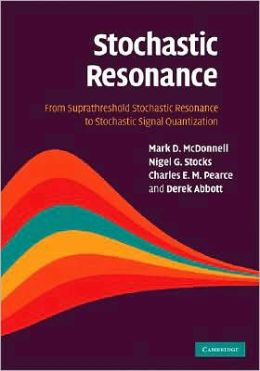 [内容简介]
[内容简介]
Stochastic resonance occurs when random noise provides a signal processing benefit, and has been observed in many physical and biological systems. Many aspects have been hotly debated by scientists for nearly 30 years, with one of the main questions being whether biological neurons utilize stochastic resonance. This book addresses in detail various theoretical aspects of stochastic resonance with a focus on its extension to suprathreshold stochastic resonance, in the context of stochastic signal quantization theory. Models in which suprathreshold stochastic resonance occur support significantly enhanced "noise benefits", and exploitation of the effect may prove extremely useful in the design of future engineering systems such as distributed sensor networks, nano-electronics, and biomedical prosthetics.
[目录]
List of figures x
List of tables xiv
Preface xv
Foreword xvii
Acknowledgments xix
1 Introduction and motivation 1
1.1 Background and motivation 1
1.2 From stochastic resonance to stochastic signal quantization 3
1.3 Outline of book 4
2 Stochastic resonance: its definition, history, and debates 6
2.1 Introducing stochastic resonance 6
2.2 Questions concerning stochastic resonance 9
2.3 Defining stochastic resonance 10
2.4 A brief history of stochastic resonance 14
2.5 Paradigms of stochastic resonance 20
2.6 How should I measure thee? Let me count the ways... 30
2.7 Stochastic resonance and information theory 34
2.8 Is stochastic resonance restricted to subthreshold signals? 39
2.9 Does stochastic resonance occur in vivo in neural systems? 45
2.10 Chapter summary 46
3 Stochastic quantization 47
3.1 Information and quantization theory 47
3.2 Entropy, relative entropy, and mutual information 48
3.3 The basics of lossy source coding and quantization theory 49
3.4 Differences between stochastic quantization and dithering 52
3.5 Estimation theory 58
3.6 Chapter summary 58
4 Suprathreshold stochastic resonance: encoding 59
4.1 Introduction 59
4.2 Literature review 61
4.3 Suprathreshold stochastic resonance 67
4.4 Channel capacity for SSR 101
4.5 SSR as stochastic quantization 112
4.6 Chapter summary 117
5 Suprathreshold stochastic resonance: large N encoding 120
5.1 Introduction 120
5.2 Mutual information when fx(x) = fη(θ - x) 125
5.3 Mutual information for uniform signal and noise 131
5.4 Mutual information for arbitrary signal and noise 135
5.5 A General expression for large N channel capacity150
5.6 Channel capacity for 'matched' signal and noise 158
5.7 Chapter summary 163
6 Suprathreshold stochastic resonance: decoding 167
6.1 Introduction 167
6.2 Averaging without thresholding 172
6.3 Linear decoding theory 174
6.4 Linear decoding for SSR 179
6.5 Nonlinear decoding schemes 195
6.6 Decoding analysis 206
6.7 An estimation perspective 213
6.8 Output signal-to-noise ratio 225
6.9 Chapter summary 230
7 Suprathreshold stochastic resonance: large N decoding 233
7.1 Introduction 233
7.2 Mean square error distortion for large N 234
7.3 Large N estimation perspective 241
7.4 Discussion on stochastic resonance without tuning 244
7.5 Chapter Summary 246
8 Optimal stochastic quantization 248
8.1 Introduction 248
8.2 Optimal quantization model 252
8.3 Optimization solution algorithms 258
8.4 Optimal quantization for mutual information 260
8.5 Optimal quantization for MSE distortion 268
8.6 Discussion of results 271
8.7 Locating the final bifurcation 286
8.8 Chapter summary 289
9 SSR, neural coding, and performance tradeoffs 291
9.1 Introduction 291
9.2 Information theory and neural coding 296
9.3 Rate-distortion tradeoff 309
9.4 Chapter summary 321
10 Stochastic resonance in the auditory system 323
10.1 Introduction 323
10.2 The effect of signal distribution on stochastic resonance 324
10.3 Stochastic resonance in an auditory model 330
10.4 Stochastic resonance in cochlear implants 344
10.5 Chapter summary 356
11 The future of stochastic resonance and suprathreshold stochastic resonance 358
11.1 Putting it all together 358
11.2 Closing remarks 360
Appendix 1 Suprathreshold stochastic resonance 362
A1.1 Maximum values and modes of Py/x(n/x) 362
A1.2 A proof of Equation (4.38) 363
A1.3 Distributions 363
A1.4 Proofs that fQ (τ) is a PDF, for specific cases 370
A1.5 Calculating mutual information by numerical integration 371
Appendix 2 Large N suprathreshold stochastic resonance 373
A2.1 Proof of Eq. (5.14) 373
A2.2 Derivation of Eq. (5.18) 374
A2.3 Proof that fs(x) is a PDF 375
Appendix 3 Suprathreshold stochastic resonance decoding 377
A3.1 Conditional output moments 377
A3.2 Output moments 378
A3.3 Correlation and correlation coefficient expressions 380
A3.4 A proof of Prudnikov's integral 382
A3.5 Minimum mean square error distortion decoding 385
A3.6 Fisher information 388
A3.7 Proof of the information and Cramer-Rao bounds 390
References 392
List of abbreviations 417
Index 419
Biographies 421

 新书报道
新书报道